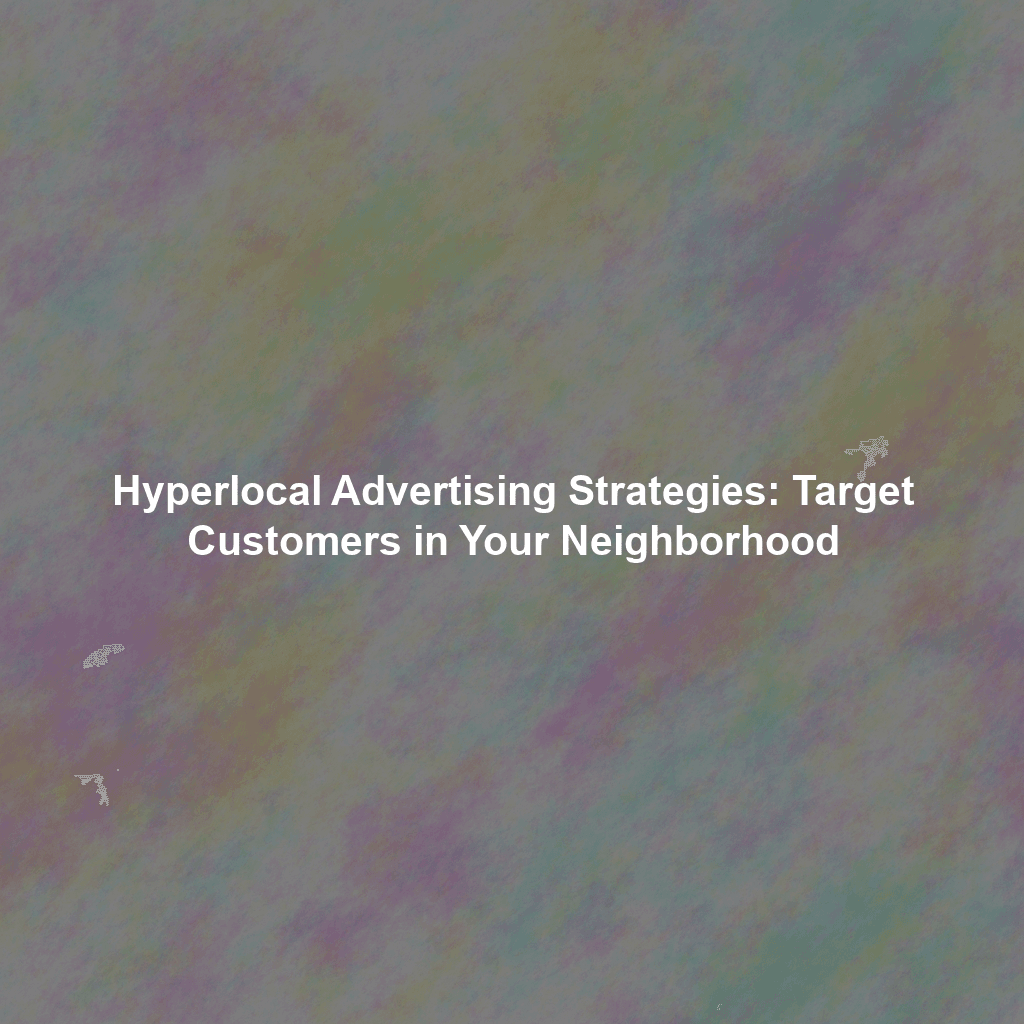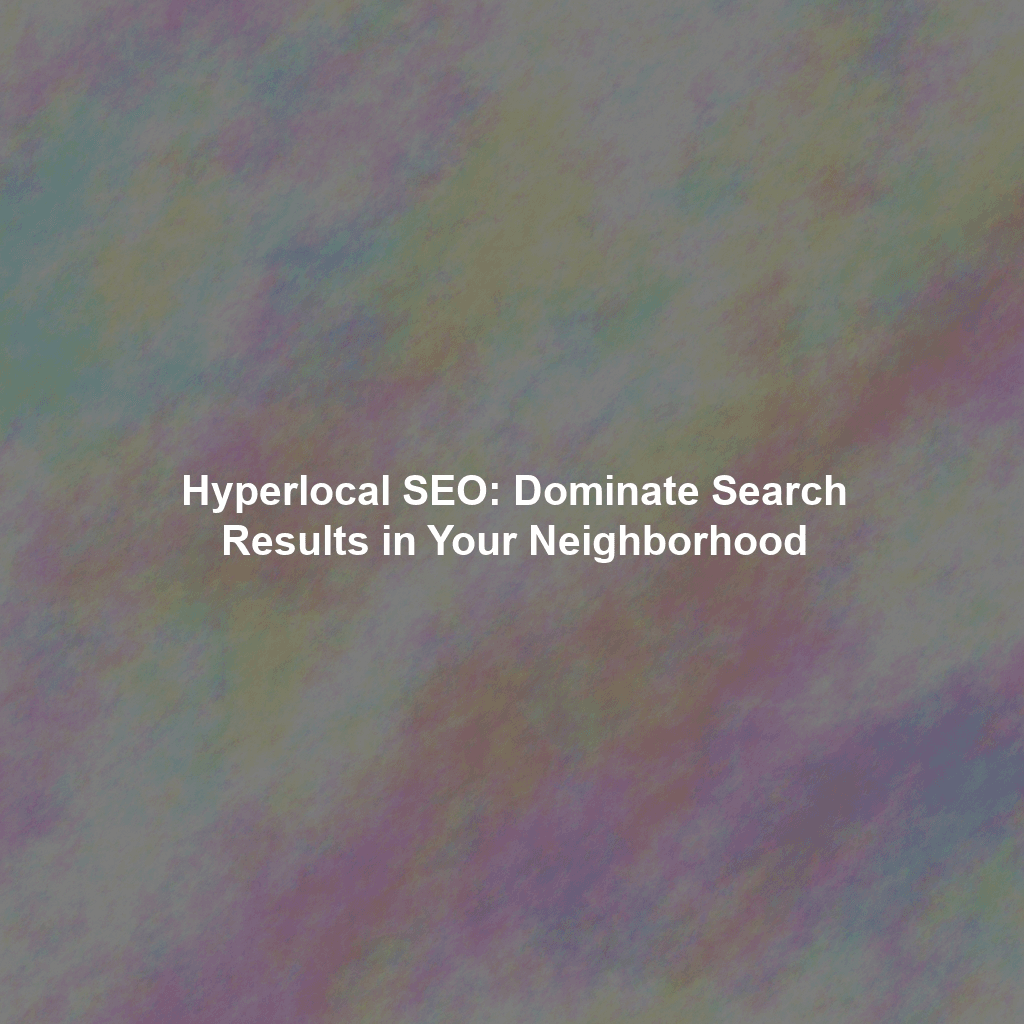Why Go Hyperlocal? The Benefits of Neighborhood-Focused Marketing
Why should you narrow your focus when the world is at your fingertips? The answer lies in the unique advantages that hyperlocal advertising offers:
- Increased Relevance: Your message speaks directly to the needs and interests of people in your immediate area, making it far more relevant and impactful. Imagine promoting a snow removal service specifically to residents when a blizzard hits your town.
- Higher Conversion Rates: People are more likely to patronize businesses that are easily accessible and convenient. Hyperlocal ads drive foot traffic and online orders from customers who are already predisposed to choose local options.
- Cost-Effectiveness: Targeting a smaller geographic area means you spend less on advertising and get a higher return on investment. You’re not wasting resources on reaching people who are unlikely to become customers.
- Stronger Community Ties: Hyperlocal marketing allows you to build relationships with your neighbors, fostering a sense of loyalty and creating brand advocates within your community.
- Competitive Edge: In a crowded marketplace, hyperlocal advertising can help you stand out from the competition by focusing on a specific niche and catering to the unique needs of your local customers.
Hyperlocal Advertising Strategies: Reaching Your Neighbors Effectively
Now that you understand the benefits, let’s explore some practical hyperlocal advertising strategies you can implement today:
1. Local SEO Optimization: Claim Your Digital Territory
Search Engine Optimization (SEO) is crucial for any business, but it’s even more critical for hyperlocal success. When people search for “pizza near me” or “plumbers in [your town],” you want your business to be at the top of the results. Here’s how to optimize for local SEO:
- Google My Business (GMB): Claim and optimize your Google My Business listing. This is your digital storefront on Google. Ensure your business name, address, phone number (NAP), website URL, business hours, and description are accurate and up-to-date. Add high-quality photos and videos of your business.
- Local Keyword Research: Identify the keywords your target customers are using to search for businesses like yours in your area. Use tools like Google Keyword Planner or Ahrefs to find relevant keywords with local intent.
- On-Page Optimization: Incorporate your target keywords into your website’s title tags, meta descriptions, headings, and content. Create location-specific landing pages that highlight your services and address the needs of local customers.
- Local Link Building: Acquire backlinks from other local businesses, organizations, and community websites. This signals to search engines that your business is a reputable part of the local ecosystem.
- Online Reviews: Encourage your customers to leave positive reviews on Google, Yelp, and other relevant review platforms. Reviews are a powerful ranking factor and can significantly influence customer decisions.
2. Social Media Targeting: Connect with Your Community Online
Social media platforms offer powerful targeting capabilities that allow you to reach specific demographics and geographic locations. Here’s how to leverage social media for hyperlocal advertising:
- Geotargeting: Use geotargeting options on platforms like Facebook, Instagram, and Twitter to target users within a specific radius of your business. You can also target users who have recently visited a particular location.
- Local Content: Create content that resonates with your local audience. Share news about local events, highlight community initiatives, and showcase your involvement in the neighborhood.
- Run Local Ads: Create targeted ad campaigns that promote special offers, discounts, or events specifically for local customers. Use compelling visuals and persuasive copy to grab their attention.
- Engage with Your Followers: Respond to comments and messages promptly, participate in local conversations, and build relationships with your followers.
- Utilize Local Hashtags: Use relevant local hashtags in your posts to increase your visibility among users who are searching for local content.
3. Local Listings and Directories: Be Found Where Your Customers Are Looking
List your business on local directories and online platforms that cater to local communities. These listings can improve your online visibility and drive traffic to your website and physical store.
- Yelp: Create and optimize your Yelp profile, ensuring your business information is accurate and complete.
- Bing Places for Business: Claim and optimize your Bing Places for Business listing.
- Local Directories: Submit your business to other relevant local directories, such as Yellow Pages, Citysearch, and local business associations.
- Industry-Specific Directories: List your business on industry-specific directories that cater to your niche.
4. Hyperlocal Content Marketing: Become a Trusted Resource
Create valuable and informative content that addresses the needs and interests of your local community. This can establish you as a trusted resource and attract potential customers to your business.
- Local Blog: Create a blog on your website that covers topics relevant to your local community. Share tips, advice, and insights that are useful to your target audience.
- Local Events Calendar: Create a calendar of local events on your website or social media pages. This can attract visitors who are looking for things to do in the area.
- Local Guides: Create guides that showcase the best things to do, see, and eat in your neighborhood.
- Customer Stories: Share stories about your local customers and how your business has helped them.
5. Community Involvement: Building Relationships Offline
Don’t underestimate the power of face-to-face interaction. Get involved in your local community to build relationships and raise awareness of your business.
- Sponsor Local Events: Sponsor local events, such as festivals, sports tournaments, and charity fundraisers.
- Partner with Local Businesses: Collaborate with other local businesses to cross-promote each other’s products and services.
- Volunteer Your Time: Volunteer your time at local organizations and charities.
- Attend Community Meetings: Attend community meetings to stay informed about local issues and connect with other residents.
6. Targeted Print Advertising: Reaching Homes Directly
While digital is dominant, traditional print advertising still has a place in hyperlocal strategies. Consider these options:
- Direct Mail: Send targeted direct mail pieces to households within a specific radius of your business.
- Local Newspapers and Magazines: Advertise in local newspapers and magazines that cater to your target audience.
- Flyers and Posters: Distribute flyers and posters in high-traffic areas, such as community centers, libraries, and local businesses.
7. Mobile Advertising: Reach Customers on the Go
Leverage mobile advertising platforms to reach customers who are on the go in your local area. Consider:
- Location-Based Ads: Use location-based ads on platforms like Google Ads and Facebook Ads to target users who are near your business.
- Mobile App Advertising: Advertise within mobile apps that are popular with your target audience.
- SMS Marketing: Send text message promotions to customers who have opted in to receive them.
Tracking and Measuring Your Hyperlocal Success
It’s crucial to track and measure the results of your hyperlocal advertising efforts to determine what’s working and what’s not. Key metrics to monitor include:
- Website Traffic: Track website traffic from local sources.
- Online Conversions: Monitor online conversions, such as online orders and appointment bookings.
- Foot Traffic: Measure foot traffic to your physical store.
- Phone Calls: Track phone calls generated by your advertising campaigns.
- Sales: Analyze sales data to identify trends and patterns.
- Customer Feedback: Collect customer feedback through surveys and reviews.
Use analytics tools like Google Analytics and Google Search Console to track your website traffic and online conversions. Regularly review your data and adjust your strategies as needed to optimize your results. Don’t be afraid to experiment with different approaches to find what works best for your business and your local community.
Finding the Right Partner: “Marketing Agencies Near Me” and Hyperlocal Expertise
Implementing a successful hyperlocal advertising strategy can be complex and time-consuming. If you’re feeling overwhelmed, consider partnering with a “marketing agency near me” that specializes in local marketing. Look for an agency that has experience with:
- Local SEO
- Social Media Marketing
- Local Content Marketing
- Online Reputation Management
- Paid Advertising
A good marketing agency will work with you to develop a customized hyperlocal advertising strategy that aligns with your business goals and target audience. They can also help you track your results and make adjustments as needed to ensure your success. When evaluating potential agencies, ask about their experience with similar businesses in your area and their track record of success. Be sure to check their references and read online reviews. Finding the right partner can make all the difference in achieving your hyperlocal marketing goals.
Conclusion: Embrace the Power of Local
Hyperlocal advertising offers a powerful way to connect with customers in your neighborhood, build community ties, and boost your business. By implementing the strategies outlined in this guide, you can unlock the potential of your local market and achieve sustainable growth. Remember to continuously adapt your approach based on data and feedback, and don’t hesitate to seek professional help from “marketing agencies near me” if you need it. Embrace the power of local, and watch your business thrive.
 Skip to content
Skip to content

